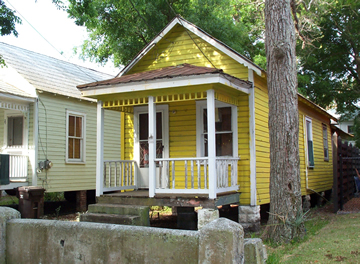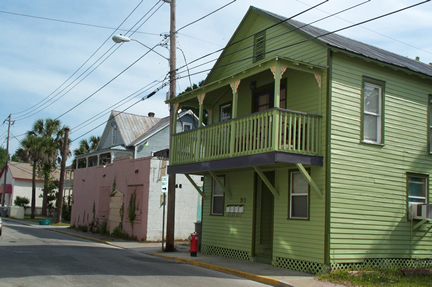Threatened Structures
Threatened Features
La Punta Community
Mission Archeological Site
The
City’s Civil Rights
Landmarks
Threatened Districts
 |
 |
A brief history of real estate sales reveals rapidly rising prices for places
in Lincolnville. But worry within the community is that its architectural and
cultural character will be lost in a sea of inappropriate replacement doors,
windows, siding, porches and Victorian gingerbread decorations.
Lincolnville is bordered by King and Bridge streets on the north, Washington Street and the banks of Maria Sanchez Lake on its east and the San Sebastian River along its southern tip and to the west. Lincolnville began its life as a community in 1866, the year after the end of the Civil War. Recently emancipated African-American slaves began to move into the area, which had earlier been home to Native American villages, followed by plantations and citrus groves. After the success of the civil rights movement, as with many black communities throughout the United States, Lincolnville residents began to move out of the black community. With desegregation, Lincolnville’s businesses lost patrons to newly available shops and eateries located in areas beyond the black community. Economic decline and passive neglect resulted.
In 1991, Lincolnville Historic District was added to the National Register of Historic Places. Subdivisions within Lincolnville had been laid out often with small lots, thus the houses of Lincolnville were close together. Much of Lincolnville was a community of small houses on small lots. The Register noted that many of the buildings were designed and built by black builders.
At the time of Lincolnville’s inclusion in the National Register, 13 years ago, there were 688 buildings within the district, 548 of historical interest. Today, an inventory would reveal a sad loss of great significance. The National Register imposes no restrictions or regulation on property, except when federal funds or federal agencies are involved. Protective regulation must come from local government. There have been attempts to have St. Augustine’s City Commission establish protective legislation for Lincolnville but those attempts have failed. The Lincolnville Neighborhood Association, a recently formed organization of area residents, wants protective zoning and design guidelines. It is a push for regulation coming from within the community, a true grass-roots movement. The spotlight needs to fall on the struggling Lincolnville historic district in an effort to help it help itself; to get city government involved to act — and as the saying goes, to act yesterday.